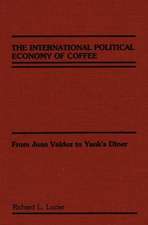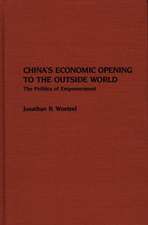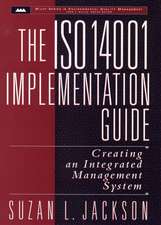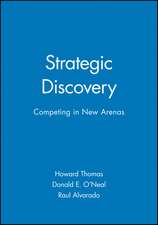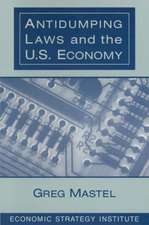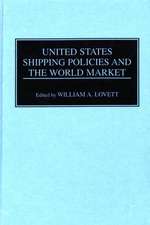The World That Trade Created: Society, Culture, and the World Economy, 1400 to the Present
Autor Kenneth Pomeranz, Steven Topiken Limba Engleză Hardback – 28 sep 2017
Covering over seven hundred years of history, this book, now in its fourth edition, takes the reader around the world from the history of the opium trade to pirates, to the building of corporations and migration to the New World. The chapters are grouped thematically, each featuring an introductory essay designed to synthesize and elaborate on key themes, both familiar and unfamiliar. It includes ten new essays, on topics ranging from the early modern ivory and slave trades across the Indian Ocean, to the ways in which the availability of new consumer goods helped change work habits in both Europe and East Asia, and from the history of chewing gum to that of rare earth metals. The introductory essays for each chapter, the overall introduction and epilogue, and several of the essays have also been revised and updated.
The World That Trade Created continues to be a key resource for anyone teaching world history, world civilization, and the history of international trade.
| Toate formatele și edițiile | Preț | Express |
|---|---|---|
| Paperback (1) | 450.40 lei 6-8 săpt. | |
| Taylor & Francis – 3 oct 2017 | 450.40 lei 6-8 săpt. | |
| Hardback (1) | 1225.18 lei 6-8 săpt. | |
| Taylor & Francis – 28 sep 2017 | 1225.18 lei 6-8 săpt. |
Preț: 1225.18 lei
Preț vechi: 1494.12 lei
-18% Nou
Puncte Express: 1838
Preț estimativ în valută:
234.43€ • 244.79$ • 193.59£
234.43€ • 244.79$ • 193.59£
Carte tipărită la comandă
Livrare economică 15-29 aprilie
Preluare comenzi: 021 569.72.76
Specificații
ISBN-13: 9781138680739
ISBN-10: 1138680737
Pagini: 358
Ilustrații: 40
Dimensiuni: 156 x 234 x 21 mm
Greutate: 0.66 kg
Ediția:4th edition
Editura: Taylor & Francis
Colecția Routledge
Locul publicării:Oxford, United Kingdom
ISBN-10: 1138680737
Pagini: 358
Ilustrații: 40
Dimensiuni: 156 x 234 x 21 mm
Greutate: 0.66 kg
Ediția:4th edition
Editura: Taylor & Francis
Colecția Routledge
Locul publicării:Oxford, United Kingdom
Cuprins
Introduction
Chapter 1 The Making of Market Conventions
2.1 Human Ingenuity: Adapting to Natural Barriers, and Creating New Ones
2.2 Power-Driven Transport: New Time, New Space, Old Conflicts
2.3 Woods, Winds, Shipbuilding, and Shipping: Why China Didn’t Rule the Waves
2.4 Better to Be Lucky Than Smart
2.5 Seats of Government and Their Stomachs: An Eighteenth-Century Tour
2.6 Pioneers of Dusty Rooms: Warehouses, Transatlantic Trade, and the Opening of the North American Frontier
2.7 People Patterns: Was the Real America Sichuan?
2.8 Winning Raffles
2.9 Trade, Disorder, and Progress: Creating Shanghai, 1840–1930
2.10 Out of One—Many
2.11 Guaranteed Profits and Half-Fulfilled Hopes: Railroad Building in British India
2.12 A Brief Trip Across the Centuries
Chapter 3 The Economic Culture of Drugs
3.1 Chocolate: From Coin to Commodity
3.2 Brewing Up a Storm
3.3 Mocha Is Not Chocolate
3.4 The Brew of Business: Coffee’s Life Story
3.5 America and the Coffee Bean
3.6 Sweet Revolutions
3.7 Paying for Power: "Sin Taxes" and the Rise of the Modern State
3.8 How Opium Made the World Go ‘Round
3.9 Tobacco: the Rise and Decline of a Magical Weed
3.10 Making Smoking Modern: From Pipes to Cigarettes in Egypt and Elsewhere
3.11 Chewing Is Good, Snorting Isn’t: How Chemistry Turned a Good Thing Bad
Chapter 4 Transplanting
4.1 Unnatural Resources
4.2 Bouncing Around
4.3 Golden Misfortune: John Sutter in the Wilds of California
4.4 California Gold and the World
4.5 El Dorado or Wild Coast? How a Remote Place was washed by the Tides of World History
4.6 Beautiful Bugs
4.7 How to Turn Nothing into Something: Guano’s Ephemeral Fortunes
4.8 As American as Sugar and Pineapples
4.9 How the Cows Ate the Cowboys
4.10 The Tie That Bound
4.11 The Good Earth?
4.12 One Potato, Two Potato
4.13 Cocoa and Coercion: Advances and Retreats for Free Labor in West African Agriculture
4.14 Trying to Get a Grip: Natural Rubber’s Century of Ups and Downs
Chapter 5 The Economics of Violence
5.1 The Logic of an Immoral Trade
5.2 As Rich as Potosí
5.3 The Freebooting Founders of England's Free Seas
5.4 Adventure, Trade, Piracy: Anthony Shirley and Pedro Teixeira, Two Early Modern Travelers
5.5 The Luxurious Life of Robinson Crusoe
5.6 No Islands in the Storm: Or, How the Sino-British Tea Trade Deluged the Worlds of Pacific Islanders
5.7 The Violent Birth of Corporations
5.8 Buccaneers as Corporate Raiders
5.9 Looking for the Next Worst Thing: Emancipation, Indentures, and Colonial Plantations After Slavery
5.10 Bloody Ivory Tower
5.11 How Africa Resisted Imperialism: Ethiopia and the World Economy
5.12 Never Again: The Saga of the Rosenfelders
Chapter 6 Making Modern Markets
6.1 Silver and Gold in Mexico and Brazil
6.2 Weighing the World: The Metric Revolution
6.3 From Court Bankers to Architects of the Modern World Market: The Rothschilds
6.4 Growing Global: International Grain Markets
6.5 How Time Got That Way
6.6 How the United States Joined the Big Leagues
6.7 Clubs, Casinos, and Collapses: Sovereign Debt and Risk Management Since 1820
6.8 Fresher Is Not Better
6.9 Packaging
6.10 Trademarks: What’s in a Name?
6.11 Learning to Feel Unclean: A Global Marketing Tale
6.12 Chewing on global History: Wrigley, Adams, and the Yucatan
6.13 Things Go Better with Red, White, and Blue: How Coca-Cola Conquered Europe
6.14 Survival of the First
6.15 It Ain’t Necessarily So
6.16 Location, Location, Location: How History Trumped Geography in Andorra and Panama
Chapter 7 World Trade, Industrialization, and Deindustrialization
7.1 Sweet Industry: The First Factories
7.2 Why We Work So Hard: The Industrious Revolution and the Early Modern World
7.3 Fiber of Fortune: How Cotton Became the Fabric of the Industrial Age
7.4 Combing the World for Cotton
7.5 Killing the Golden Goose
7.6 Sweet Success
7.7 No Mill Is an Island
7.8 Feeding Silkworms, Spitting Out Growth
7.9 From Rocks—and Restrictions—to Riches: How Disadvantages Helped New England Industrialize Early
7.10 Sideways Breakthroughs and Stalled Transitions: Crooked Paths from Coal to Oil, 1859–2012
7.11 American Oil
7.12 Running on Oil, Building on Sand
7.13 Not So Rare, But Pretty Strange: How Rare Earth Metals Became a Chinese "Monopoly"
7.14 Minding the Store and Forgetting the Factory: U.S. "Fair Trade" Laws and the Rise of Offshore Manufacturing Since World War II
Epilogue: The World Economy in the Twenty-First Century
Chapter 1 The Making of Market Conventions
- The Fujian Trade Diaspora
- The Chinese Tribute System
- Funny Money, Real Growth
- When Asia Was the World Economy
- Treating Good News as No News
- Pearls in the Rubble: Rediscovering the Golden Age of Quanzhou, ca. 1000–1400
- Aztec Traders
- Primitive Accumulation: Brazilwood
- A British Merchant in the Tropics
- How the Other Half Traded
- Deals and Ordeals: World Trade and Early Modern Legal Culture
- Traveling Salesmen, Traveling Taxmen
- Indian Ocean Commodity Circuit: How to Turn Cotton into Ivory
- Going Non-native: Expense Accounts and the End of the Age of Merchant Courtiers
- Empire on a Shoestring: British Adventurers and Indian Financiers in Calcutta, 1750–1850
2.1 Human Ingenuity: Adapting to Natural Barriers, and Creating New Ones
2.2 Power-Driven Transport: New Time, New Space, Old Conflicts
2.3 Woods, Winds, Shipbuilding, and Shipping: Why China Didn’t Rule the Waves
2.4 Better to Be Lucky Than Smart
2.5 Seats of Government and Their Stomachs: An Eighteenth-Century Tour
2.6 Pioneers of Dusty Rooms: Warehouses, Transatlantic Trade, and the Opening of the North American Frontier
2.7 People Patterns: Was the Real America Sichuan?
2.8 Winning Raffles
2.9 Trade, Disorder, and Progress: Creating Shanghai, 1840–1930
2.10 Out of One—Many
2.11 Guaranteed Profits and Half-Fulfilled Hopes: Railroad Building in British India
2.12 A Brief Trip Across the Centuries
Chapter 3 The Economic Culture of Drugs
3.1 Chocolate: From Coin to Commodity
3.2 Brewing Up a Storm
3.3 Mocha Is Not Chocolate
3.4 The Brew of Business: Coffee’s Life Story
3.5 America and the Coffee Bean
3.6 Sweet Revolutions
3.7 Paying for Power: "Sin Taxes" and the Rise of the Modern State
3.8 How Opium Made the World Go ‘Round
3.9 Tobacco: the Rise and Decline of a Magical Weed
3.10 Making Smoking Modern: From Pipes to Cigarettes in Egypt and Elsewhere
3.11 Chewing Is Good, Snorting Isn’t: How Chemistry Turned a Good Thing Bad
Chapter 4 Transplanting
4.1 Unnatural Resources
4.2 Bouncing Around
4.3 Golden Misfortune: John Sutter in the Wilds of California
4.4 California Gold and the World
4.5 El Dorado or Wild Coast? How a Remote Place was washed by the Tides of World History
4.6 Beautiful Bugs
4.7 How to Turn Nothing into Something: Guano’s Ephemeral Fortunes
4.8 As American as Sugar and Pineapples
4.9 How the Cows Ate the Cowboys
4.10 The Tie That Bound
4.11 The Good Earth?
4.12 One Potato, Two Potato
4.13 Cocoa and Coercion: Advances and Retreats for Free Labor in West African Agriculture
4.14 Trying to Get a Grip: Natural Rubber’s Century of Ups and Downs
Chapter 5 The Economics of Violence
5.1 The Logic of an Immoral Trade
5.2 As Rich as Potosí
5.3 The Freebooting Founders of England's Free Seas
5.4 Adventure, Trade, Piracy: Anthony Shirley and Pedro Teixeira, Two Early Modern Travelers
5.5 The Luxurious Life of Robinson Crusoe
5.6 No Islands in the Storm: Or, How the Sino-British Tea Trade Deluged the Worlds of Pacific Islanders
5.7 The Violent Birth of Corporations
5.8 Buccaneers as Corporate Raiders
5.9 Looking for the Next Worst Thing: Emancipation, Indentures, and Colonial Plantations After Slavery
5.10 Bloody Ivory Tower
5.11 How Africa Resisted Imperialism: Ethiopia and the World Economy
5.12 Never Again: The Saga of the Rosenfelders
Chapter 6 Making Modern Markets
6.1 Silver and Gold in Mexico and Brazil
6.2 Weighing the World: The Metric Revolution
6.3 From Court Bankers to Architects of the Modern World Market: The Rothschilds
6.4 Growing Global: International Grain Markets
6.5 How Time Got That Way
6.6 How the United States Joined the Big Leagues
6.7 Clubs, Casinos, and Collapses: Sovereign Debt and Risk Management Since 1820
6.8 Fresher Is Not Better
6.9 Packaging
6.10 Trademarks: What’s in a Name?
6.11 Learning to Feel Unclean: A Global Marketing Tale
6.12 Chewing on global History: Wrigley, Adams, and the Yucatan
6.13 Things Go Better with Red, White, and Blue: How Coca-Cola Conquered Europe
6.14 Survival of the First
6.15 It Ain’t Necessarily So
6.16 Location, Location, Location: How History Trumped Geography in Andorra and Panama
Chapter 7 World Trade, Industrialization, and Deindustrialization
7.1 Sweet Industry: The First Factories
7.2 Why We Work So Hard: The Industrious Revolution and the Early Modern World
7.3 Fiber of Fortune: How Cotton Became the Fabric of the Industrial Age
7.4 Combing the World for Cotton
7.5 Killing the Golden Goose
7.6 Sweet Success
7.7 No Mill Is an Island
7.8 Feeding Silkworms, Spitting Out Growth
7.9 From Rocks—and Restrictions—to Riches: How Disadvantages Helped New England Industrialize Early
7.10 Sideways Breakthroughs and Stalled Transitions: Crooked Paths from Coal to Oil, 1859–2012
7.11 American Oil
7.12 Running on Oil, Building on Sand
7.13 Not So Rare, But Pretty Strange: How Rare Earth Metals Became a Chinese "Monopoly"
7.14 Minding the Store and Forgetting the Factory: U.S. "Fair Trade" Laws and the Rise of Offshore Manufacturing Since World War II
Epilogue: The World Economy in the Twenty-First Century
Recenzii
‘In this collection of short essays, Pomeranz and Topik masterfully depict the story of the creation of the world economy. Without using academic jargon, they explain how trade with commodities, drugs, animals, people and ideas moved among continents and transformed the world.’ — Manel Ollé, associate tenure professor in Modern and contemporary Chinese history and culture, Director of the Master in Chinese Studies, Universitat Pompeu Fabra, Barcelona, Spain
‘How invisible networks of trade ultimately came to compel producers, merchants, and even whole societies to adapt to the networks' needs as they grew is a fascinating story, and one just as important for understanding the world as developments in politics or culture are. I know of no other book that introduces trade networks so well. It is an ideal text for survey courses.’ — Roland Spickermann - Chair, Dept. of History, University of Texas of the Permian Basin, USA
‘How invisible networks of trade ultimately came to compel producers, merchants, and even whole societies to adapt to the networks' needs as they grew is a fascinating story, and one just as important for understanding the world as developments in politics or culture are. I know of no other book that introduces trade networks so well. It is an ideal text for survey courses.’ — Roland Spickermann - Chair, Dept. of History, University of Texas of the Permian Basin, USA
Descriere
Covering over seven hundred years of history, this book, now in its fourth edition, takes the reader around the world from the history of the opium trade to pirates, to the building of corporations and migration to the New World. It includes ten new essays, on topics ranging from the early modern ivory and slave trades across the Indian Ocean, to the ways in which the availability of new consumer goods helped changed work habits in both Europe and East Asia, and from the history of chewing gum to that of rare earth metals.

